Co-ordinate regulation of cytokinin gene family members during flag leaf and reproductive development in wheat
- PMID: 22672647
- PMCID: PMC3410795
- DOI: 10.1186/1471-2229-12-78
Co-ordinate regulation of cytokinin gene family members during flag leaf and reproductive development in wheat
Abstract
Background: As the global population continues to expand, increasing yield in bread wheat is of critical importance as 20% of the world's food supply is sourced from this cereal. Several recent studies of the molecular basis of grain yield indicate that the cytokinins are a key factor in determining grain yield. In this study, cytokinin gene family members in bread wheat were isolated from four multigene families which regulate cytokinin synthesis and metabolism, the isopentenyl transferases (IPT), cytokinin oxidases (CKX), zeatin O-glucosyltransferases (ZOG), and β-glucosidases (GLU). As bread wheat is hexaploid, each gene family is also likely to be represented on the A, B and D genomes. By using a novel strategy of qRT-PCR with locus-specific primers shared among the three homoeologues of each family member, detailed expression profiles are provided of family members of these multigene families expressed during leaf, spike and seed development.
Results: The expression patterns of individual members of the IPT, CKX, ZOG, and GLU multigene families in wheat are shown to be tissue- and developmentally-specific. For instance, TaIPT2 and TaCKX1 were the most highly expressed family members during early seed development, with relative expression levels of up to 90- and 900-fold higher, respectively, than those in the lowest expressed samples. The expression of two cis-ZOG genes was sharply increased in older leaves, while an extremely high mRNA level of TaGLU1-1 was detected in young leaves.
Conclusions: Key genes with tissue- and developmentally-specific expression have been identified which would be prime targets for genetic manipulation towards yield improvement in bread wheat breeding programmes, utilising TILLING and MAS strategies.
Figures
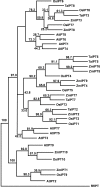
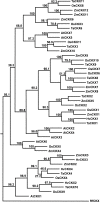
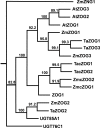
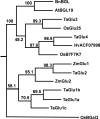


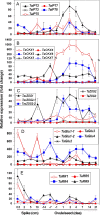
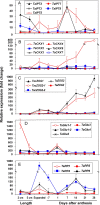
Similar articles
-
Cytokinin dehydrogenase: a genetic target for yield improvement in wheat.Plant Biotechnol J. 2020 Mar;18(3):614-630. doi: 10.1111/pbi.13305. Epub 2019 Dec 22. Plant Biotechnol J. 2020. PMID: 31782596 Free PMC article. Review.
-
Specificity of expression of TaCKX family genes in developing plants of wheat and their co-operation within and among organs.PLoS One. 2019 Apr 10;14(4):e0214239. doi: 10.1371/journal.pone.0214239. eCollection 2019. PLoS One. 2019. PMID: 30969991 Free PMC article.
-
Expression patterns of Brassica napus genes implicate IPT, CKX, sucrose transporter, cell wall invertase, and amino acid permease gene family members in leaf, flower, silique, and seed development.J Exp Bot. 2015 Aug;66(16):5067-82. doi: 10.1093/jxb/erv133. Epub 2015 Apr 4. J Exp Bot. 2015. PMID: 25873685 Free PMC article.
-
The Expression of TaRca2-α Gene Associated with Net Photosynthesis Rate, Biomass and Grain Yield in Bread Wheat (Triticum aestivum L.) under Field Conditions.PLoS One. 2016 Aug 22;11(8):e0161308. doi: 10.1371/journal.pone.0161308. eCollection 2016. PLoS One. 2016. PMID: 27548477 Free PMC article.
-
Cytokinin glucosyl transferases, key regulators of cytokinin homeostasis, have potential value for wheat improvement.Plant Biotechnol J. 2021 May;19(5):878-896. doi: 10.1111/pbi.13595. Plant Biotechnol J. 2021. PMID: 33811433 Free PMC article. Review.
Cited by
-
Seed yield as a function of cytokinin-regulated gene expression in wild Kentucky bluegrass (Poa pratensis).BMC Plant Biol. 2024 Jul 20;24(1):691. doi: 10.1186/s12870-024-05421-w. BMC Plant Biol. 2024. PMID: 39030468 Free PMC article.
-
The LONELY GUY gene family: from mosses to wheat, the key to the formation of active cytokinins in plants.Plant Biotechnol J. 2022 Apr;20(4):625-645. doi: 10.1111/pbi.13783. Epub 2022 Mar 1. Plant Biotechnol J. 2022. PMID: 35108444 Free PMC article. Review.
-
Expression of Genes Related to Sugar and Amino Acid Transport and Cytokinin Metabolism during Leaf Development and Senescence in Pisum sativum L.Plants (Basel). 2019 Mar 25;8(3):76. doi: 10.3390/plants8030076. Plants (Basel). 2019. PMID: 30934599 Free PMC article.
-
Differential Gene Expression in the Meristem and during Early Fruit Growth of Pisum sativum L. Identifies Potential Targets for Breeding.Int J Mol Sci. 2017 Feb 16;18(2):428. doi: 10.3390/ijms18020428. Int J Mol Sci. 2017. PMID: 28212324 Free PMC article.
-
Targeting Cytokinin Homeostasis in Rapid Cycling Brassica rapa with Plant Growth Regulators INCYDE and TD-K.Plants (Basel). 2020 Dec 25;10(1):39. doi: 10.3390/plants10010039. Plants (Basel). 2020. PMID: 33375745 Free PMC article.
References
-
- International Grains Council. Grain Market report. 2010. [ www.igc.int/downloads/gmrsummary/gmrsumme.pdf]
-
- FAO. FAOSTAT. 2010. [ http://faostat.fao.org/site/368/DesktopDefault.aspx?PageID=368#ancor]
MeSH terms
Substances
LinkOut - more resources
Full Text Sources
Research Materials

